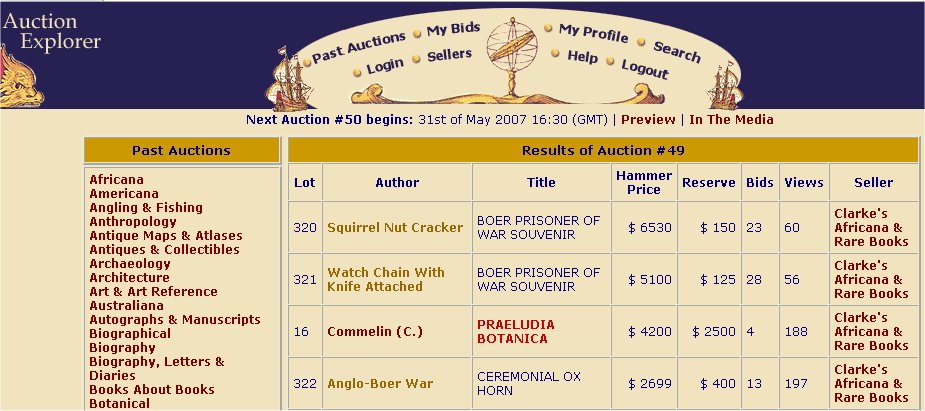Early S African Ephemera hit amazing prices at auction
April 2007 - Article by Scott Balson -
http://www.tokencoins.com
Read the reserve and hammer prices for the three top selling items on a recent
auction by Auction Explorer, a South African online auction house based in
Cape Town, and you will be stunned at what you see!

Three unusual items dating back to the Boer War fetched prices many multiples
of their reserve. In the case of the Squirrel Nut Cracker the hammer price
was over 45 times higher than anticipated!
As I noted in an earlier article this is just
the start of a growing trend as the baby boomers around the world with their
pockets full of cash now look for ways to spend it - and what better way
than an interesting hobby collecting items such as these?
Supply and demand is the great leveller in the marketplace whether it be
shares, housing or the price of collectable coins. And for those of you who
have invested wisely in ephemera you are on the road to riches - because
what you see in the links to the items below outlined above is just the
start of an explosion in value in this fast growing collectable market covering
old books, maps, coins and old stuff with an interesting history.
In closing I should note that the manner in which the Internet has allowed
people from all over the world to participate - a driving force behind prices
which will continue to explode.
 |
Squirrel Nut Cracker
175 mm long and 40 mm wide at its widest point, wood, not inscribed, no place,
no date. Identical to one in the National Army Museum, London. |
 |
Watch Chain With Knife Attached
The bone watch chain consists of 9 segments (each 15 mm in length) with 10
metal links and 300 mm in length (including the bone knife), inscribed 'J.H.L.',
' St. H'. St. Helena, No date (circa 1901). |
 |
CEREMONIAL OX HORN
Description : 290 x 65 mm, inscribed ox horn, carved with 3 note holes, circa
1900. The carved inscription reads: 'E.J. Joubert made and played this horn
as "trumpeter" on commando under Field Cornet Thring in the Kroonstad laager
at Ladysmith, January 1900'. Nothing is known of "the trumpeter of Ladysmith",
but Thring became well-known in the Boer forces during the war and was captured
at Kroonstad in April 1900. General de Wet wrote as follows about him in
'Three Years War' (pp. 116-7): 'Thring was an honourable man in every way.
Although an Englishman by birth, he was at heart an Afrikander, for he had
accepted the Orange Free State as his second fatherland. Like many another
Englishman he had become a fellow-citizen of ours, and had enjoyed the fat
of the land. But now, trusty burgher that he was, he had drawn his sword
to defend the burghers' rights. His earliest experiences were with the Kroonstad
burghers, who went down into Natal; later on he fought under me at Sanna's
Post and Mostertshoek, and took part in the siege of Colonel Dalgety at
Jammersbergsdrift. He had stood at my side at Thaba 'Nchu and on the banks
of the Zand River. I had always found him the most willing and reliable of
officers, and he had won the respect and trust of every man who knew him.
He was faithful to the end. Although he might well have joined our enemies,
he preferred to set the seal of fidelity upon his life by his imprisonment.
Long may he live to enjoy the trust of the Afrikander people'. Thring fought
with the British forces during the First World War and was decorated with
the D.S.O |


